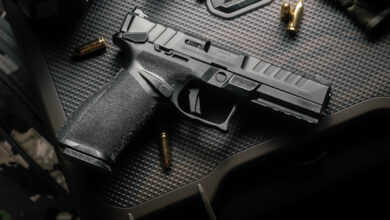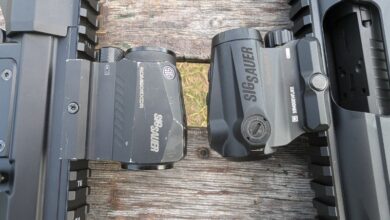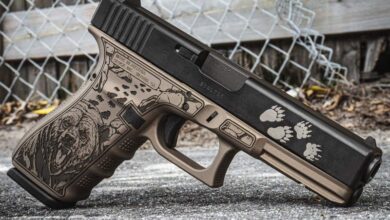Wet and Damp Ammo: How Much Moisture Is Too Much?

When the modern cartridge showed up, it was an answer to previous firearm systems that were not totally sealed from the elements. Flintlock muzzleloaders used exposed gunpowder that absorbed moisture from the air and needed to be emptied periodically. Percussion caps were more waterproof but not foolproof. Cartridges use a brass or steel case that protects the powder from the environment.
Most modern ammunition makers double that protection by using clear chemical sealants on the case mouth where the bullet enters the case, as well as over the primer at the back of the cartridge. But even with all these advancements, ammunition is not totally weatherproof, and any amount of moisture over a long enough period of time can ruin it. Wet and damp ammo is unreliable ammo.
In ideal circumstances, guns and ammo are packed away in a cool, dry place far removed from humidity and water. But in reality, guns and ammo are carried and shot. Guns and ammo have to deal with sweat, humidity, and potential mishaps with rainstorms. We know that, given enough time, ammunition can become unreliable when exposed to moisture. But at what point does that ammunition cease to be reliable? Would ammunition fire if exposed to the rain or overnight outside? What if it was submerged for a period? Would ammo still fire under those conditions, and if so, would performance degrade enough to make a difference?
Wet and Damp Ammo: A Brief Experiment
If you’ve ever asked yourself those questions, you are not alone. I live in southern Louisiana, and eight months out of the year, the heat and humidity are oppressive, with daily showers not unheard of. Our brief winters are also deceptively damp. Yet I have seen plenty of improperly stored or abandoned ammunition and wondered if it would fire.
To satisfy my curiosity, I decided to experiment to test the effectiveness of damp ammunition. I exposed three lots of ammunition to different weather conditions simultaneously over a 48-hour period. Afterward, I harvested the ammunition and shot it over my Caldwell Chronograph alongside a fourth lot of ammunition held in a low-humidity environment as a control.
To test different ammunition offerings as fairly as I could, I decided to test both rimfire and centerfire ammunition. Rimfire ammo is well known for being cantankerous and inconsistent, even when dry. I chose to test CCI Blaser 40 grain .22LR ammunition, one of the more consistent and reliable loads on the market. I paired this rimfire load with Winchester 9mm Luger 124 grain FMJ target ammunition to represent centerfire ammunition.
The lots consisted of five rounds of rimfire and five rounds of centerfire ammunition. One lot was placed in the open next to one lot in a small plastic dish. Over 48 hours, these lots were subjected to temperature and humidity levels approaching 90 degrees. Within the first hour, these lots were subjected to thirty minutes of rain. The ammunition on the ground was permitted to dry on its own, while the ammunition in the dish was left to submerge. The third lot of ammunition was placed in a dish and exposed to the humidity but kept dry from any rainfall. After 48 hours, the lots were bagged, labeled, and put into the range bag for testing.
Wet and Damp Ammo: Does It Shoot?
In testing wet and damp ammunition, I aimed to answer a few rhetorical questions. First, would the ammunition fire? Second, if it does fire, will there be any loss in velocity because of dampness infiltrating the gunpowder? Ergo, a loss in velocity would equate to a loss in accuracy, as bullets can’t be expected to hit in the same place if their speeds are across the chart. Lastly, would rimfire be inferior or superior to centerfire when exposed to moisture?
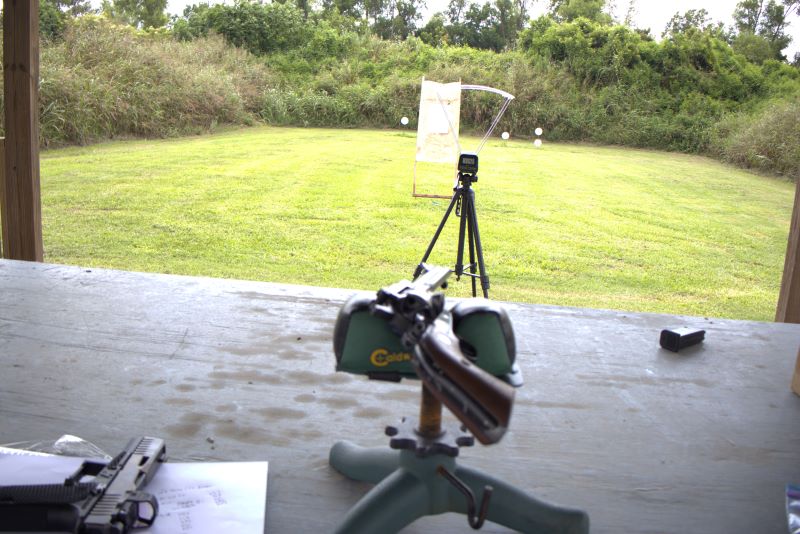
To answer those questions, I shot both the control and test ammunition across my Caldwell Chronograph from a distance of 10 feet away. For the .22 rimfire ammunition test, I used a 5.5-inch barreled Ruger Single Six. The 9mm Luger ammunition was tested with a Rainier Arms Dusk 19R with a ported 4-inch barrel. I began by firing a string of five rounds using the control ammunition, which was properly stored in a cool and dry location.
The CCI Blazer clocked in with an average velocity of 1,119 feet per second. The Winchester 9mm ammunition averaged out at 998.
Next, I fired five rounds of each test ammunition sample, starting with the lot that was exposed to humidity, followed by the lot that was exposed to humidity and a brief rain. Anticipating trouble, I saved the submerged ammunition for last.
To my surprise, the humid and hot conditions seemed to increase case pressures enough to yield literally hotter ammunition in the case of the 9mm. The humid lot yielded an average velocity of 1,116 feet per second for the .22. The 9mm ammunition clocked in at 1,096 feet per second, a net gain of 98 feet per second over properly stored ammunition. The rain-soaked ammunition came in at 1,129 and 1,106 feet per second for the .22 and 9mm, respectively. Thus far, none of the ammunition yielded wide variations. The number of shots in each string fell within a group that yielded a variation of less than 35 feet per second.
Finally, I shot through the submerged ammunition. I had never done so before and wondered how well ammunition exposed to complete submersion would fair. Rimfire ammunition has the advantage of a sealed case head and a lead, wax-covered lead bullet to make it waterproof. Modern centerfire ammunition is usually sealed with lacquer at the primer and the case mouth. Most lacquers are translucent, but coloring is often used with premium self-defense loads and foreign-manufactured ammunition. Once I submerged the ammunition, I was sure these protections would do well against quick submersion. I was less sure about prologued exposure.

I could not get through all five rounds of rimfire ammo with my Ruger. The first two rounds did not fire. The third fired. The fourth was dead. The fifth round fired. I struck the loaded rounds on a different part of the rim, but none of the dead rounds fired. For what it was worth, the two rounds that fired came in close to their humid counterparts, although the variation from one round to the next spread. One round came in at 1,136 feet per second, while the other was 1,023 feet per second.
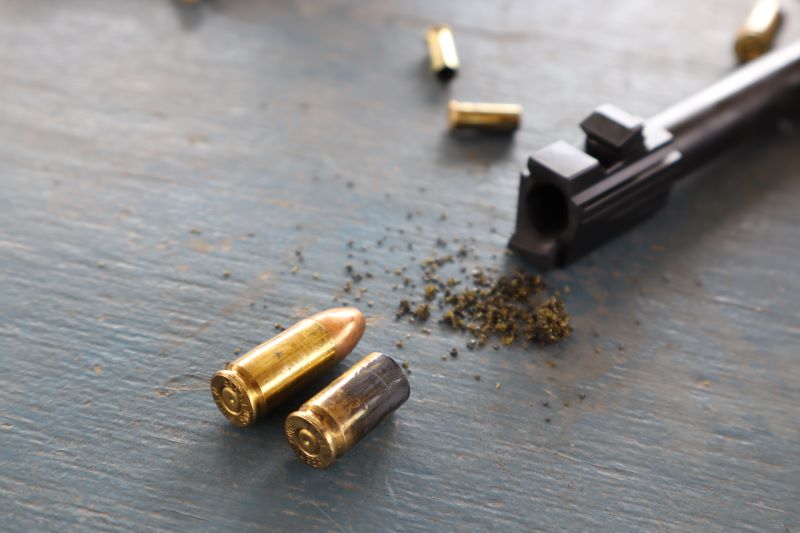
I managed to successfully fire three rounds of 9mm ammunition from the Dusk 19. The first round was noticeably underpowered and failed to fully eject. It left the muzzle and crossed the chronograph at 726 feet per second. The second round had enough energy to eject but not enough to jack the slide rearward enough to fully pick up a round. It crossed the chronograph at 958 feet per second. The third round came in at 1,110 feet per second. The fourth round was struck hard but did not go off. The fifth round’s primer popped, pushing dead and wet powder and bullet into the barrel, causing a squib load situation that would be particularly dangerous.
Wet Ammo: To Shoot or Not to Shoot
Wet ammunition can happen to anybody. How many times have you accidentally left a round or two at the bottom of your pants, only to find them again after a wash? In daily life, things like this can happen. Your everyday carry gun can be exposed to who knows how much water and perspiration. Depending on where you live and what season you are in, there is no escaping humidity, no matter how careful you are.
In this particular experiment, I mimicked sheer forgetfulness and came away surprised. Well-produced rimfire ammunition is surprisingly well-sealed, but centerfire ammunition is not necessarily more reliable. In fact, there are more ingress points once any protective coatings are washed away. But at the point between well-regulated ammunition and unreliability, I was surprised how the humidity actually made the ammunition hotter. While I am sure prologued exposure to humidity over a longer period of time would eventually kill the ammunition in the same way total submersion did, rimfire and centerfire ammunition is going to work through more abuse than you might suspect. When you choose to switch out your old ammunition for safety’s sake is ultimately up to you.
The post Wet and Damp Ammo: How Much Moisture Is Too Much? appeared first on The Mag Life.
Read the full article here


